Patriot Chronicles: Two Loyalist Recollections of the Battle of the Windmill
2018 marks the 180th anniversary of the 1838 Upper Canadian Rebellion/Patriot War. In mid-November of 1838, the Battle of the Windmill (the second last of 14 recorded armed forays from the United States into Canada) took place. Much has been written about this incident (see bibliography and recommended readings below). It is therefore always gratifying to uncover additional period recollections that detail the events associated with this incursion, and which have not received much notice. The following are the first-hand remembrances written by two loyalists, who fully supported the government efforts to repel foreign invaders, and to defend and protect the sovereignty of Upper Canada.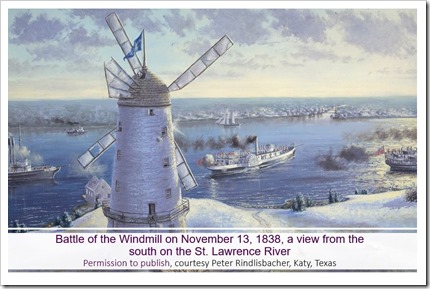
William Helliwell
The first recollection comes from the diaries of Todmorden Mills’ brewer William Helliwell. Helliwell was an astute observer of events, not only in Toronto, but throughout Upper Canada. During 1837 and 1838, he made many entries about the rebellions in both provinces. On November 14, Helliwell wrote his initial comments about the Battle of the Windmill, saying; “This morning I went to Toronto...at four oclock [o‘clock] the Governor [Sir George Arthur] recived [received] a dispach [dispatch] with the intelejance [intelligence] of the rebels and pirates having crossed over the river [St. Lawrence] and taken our fort at Prescott it has been repaired and put into a state of defence but I beleave [believe] there was no soldiers in it when it was taken possession [possession] off [of] by the rebels.” While his belief that Fort Wellington had been taken by Patriot forces was erroneous, he would continue to record his thoughts and reflections about the Battle of the Windmill.
Helliwell’s November 16 entry, was more accurate, and it also provided additional details about the Prescott encounter: “...the Team brote [brought] us Gazet [Gazette] with the news of an engagement between our forces and the brigands with the complete defeat of the latter but notwithstanding some loss as there was one Lieutenant of the 83 Regt [Regiment] and several of the militia killed and a number was wounded The loss of the brigands was soposed [supposed] to varey [vary] greate [great] as they [government forces] battered down a stone wind mill in which 40 had loged [lodged] themselves and it is reported that a greate [great] maney [many] was killed on Board the United States steamer and on board a schooner which mad[e] three attempts to cross to Prescott but was driven back by the little steamer Experiment.”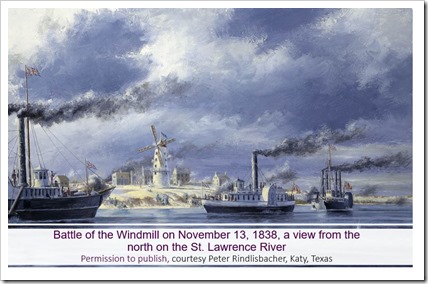
On November 17, Helliwell added; “No news from Prescott as yet – greate [great] number of militia are arriving at Toronto. Three days later, on November 20th he included the following news which had been delivered to him by his brother Joseph; “...he brote [brought] word of the surrender of the Brigands who were in the mill at Prescott 167 in number.” Helliwell’s final record about the Battle of the Windmill was penned on December 5; “There is news from Kingston that six of the Pirate Leaders are to be hung imediatly [immediately].” *
Lord Charles Beauclerk
A second reflection, written by Lord Charles Beauclerk and published in 1840, provides a military perspective about the Battle of the Windmill. Beauclerk was a Lieutenant in the 2nd Battalion, 1st Regiment of Foot (the Royals). He had landed at Quebec aboard the transport Maitland, from Cork, Ireland, in August of 1836. He was moved with his battalion in September of 1837, and then stationed in Montreal. This became the base for his involvement with loyalist forces in helping to put down several of the uprisings which occurred in Lower Canada, in late 1837. While much of his book deals with actions in Lower Canada (including seven engravings drawn by Beauclerk that depicted events there), he was engaged on one occasion in Upper Canada. On word of the rebel raid on Prescott, Beauclerk was sent with two flank companies of the Royals (commanded by Colonel George Augustus Wetherall) from Montreal to Prescott, to support loyalist troops stationed there. Even when put on a forced march, Beauclerk and his comrades arrived too late to participate in or witness the dislodgement and defeat of rebel forces at the Battle of the Windmill.
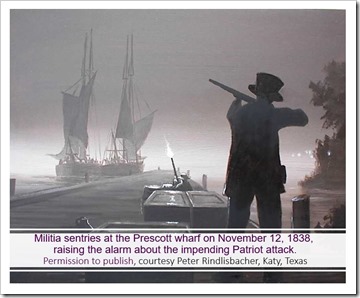 In his remembrances, Beauclerk initially noted that as in the 1837 rebellions, “...a sympathy in behalf of the disaffected Canadians now existed along the borders, and they [the Patriots] concentrated their whole force upon the Prescot (sic) frontier, with the intention of taking that town.” He continued by providing details gained from first-hand information in intelligence given to him by actual participants in and observers of the Battle of the Windmill. His account began; “At midnight of November 11, two schooners, having on board between four and five hundred men, appeared off Ogdensburg [New York], directly fronting the town of Prescot, which is bounded by the St. Lawrence, at that part about a mile wide. Suspicions of hostile intentions from the borderers had long been entertained, although the place of destination remained altogether in doubt, and as precautionary measures, a guard of observation was stationed ashore, while the naval force, under Captain [Williams] Sandon [Sandom] R.N. cruised between Kingston and Prescot.
In his remembrances, Beauclerk initially noted that as in the 1837 rebellions, “...a sympathy in behalf of the disaffected Canadians now existed along the borders, and they [the Patriots] concentrated their whole force upon the Prescot (sic) frontier, with the intention of taking that town.” He continued by providing details gained from first-hand information in intelligence given to him by actual participants in and observers of the Battle of the Windmill. His account began; “At midnight of November 11, two schooners, having on board between four and five hundred men, appeared off Ogdensburg [New York], directly fronting the town of Prescot, which is bounded by the St. Lawrence, at that part about a mile wide. Suspicions of hostile intentions from the borderers had long been entertained, although the place of destination remained altogether in doubt, and as precautionary measures, a guard of observation was stationed ashore, while the naval force, under Captain [Williams] Sandon [Sandom] R.N. cruised between Kingston and Prescot.
Consequently, the movements of the Sympathizers did not pass unheeded; the Experiment, steamer, Lieutenant [William Newton] Fowle [Fowell] R.N. mounting three guns only, was on the look-out; and on shore, a call to arms was sounded, and a general muster of all who could procure fire-arms, or other implements wherewith to repel the brigands. This force comprised a company of Glengarry volunteers enlisted in the Queen’s service; the militia of Johnstown district, only a few days arrived; with some few of the town’s men; in all not more than three hundred men; and for these there were few arms, and a small quantity of powder.” 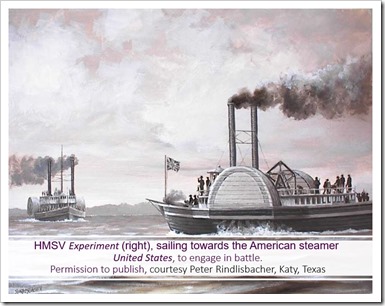
Beauclerk’s account continued, and it described the events of the next day: “At an early hour on the morning of the 12th, one of the schooners endeavoured to effect a landing at a wharf, but, to her surprise was hailed by Colonel [Plomer] Younge [Young], accompanied by Mr. [Jonas] Jones a magistrate, with about ten or twelve others; when she hoisted sail and cast anchor at her old moorings, but must have soon got under weigh again, for at half-past seven the ferry-boat Paul Pry arrived with information that the steamer United States had been forcibly seized by three hundred of her men. The report was soon verified by the United States steam-boat assuming a threatening position in mid-channel. The Experiment was, however, on the alert, and, although her crew included not more than twenty men with a few volunteers from shore, was able to keep her at bay.
The Schooners
After a time, one of the schooners dropped down the stream about a mile and a half opposite to a windmill, and commenced landing her men and arms. The United States also steered in that direction, when the Experiment fired a cannonade at her as she passed; but deemed it far from prudent to leave the town [Prescott] unprotected. The rebel steamer ran alongside the schooner, and commenced landing men.
The second schooner now approached still nearer the fort [Wellington], the Experiment bore down upon her, and discharged her guns with great effect. About mid-day the United States boat again made her appearance; but the first fire of the Experiment having done considerable damage to the steerage besides blowing off the head of the helmsman, obliged her to go into Ogdensburg to repair. The brigands had commenced throwing up an entrenchment when they landed, but to offer any resistance by land with the force then in the town was out of the question.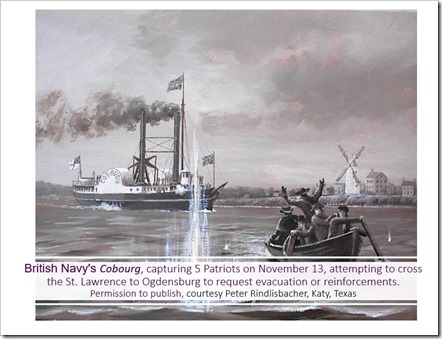
One hundred and fifty armed volunteers under Lieutenant-Colonel [Ogle] Gowan, with some spare arms and ammunition having arrived, as well as two armed steam-boats, the Coburg (sic) and Victoria, commanded by Captain [William] Sandon [Sandom] R.N. It was determined to attack the brigands in their position at seven A.M. of the 13th. Reinforced by twenty-five men of the 83rd regiment under Lieutenant [William Stratford] Johnson, and forty marines under Lieutenant [Charles] Parker, being the whole complement from on board the steam-boats under Captain Sandon, Lieutenant-Colonel [Plomer] Young commenced the attack by a simultaneous movement on two sides while Captain Sandon was to attract their three field-pieces by his fire on the water front.
The left column, destined to turn to the enemies’ right, was led by Lieutenant-Colonel [Richard] Frazer [Fraser] of the Militia, composed of Lieutenant Parker’s men, the Glengarry Volunteers under Captain [George] Macdonell, and a force of Grenville and Stormont militia under Colonel Martel [probably Colonel George Merkley], and Captain [Dunham] Jones and [Simon B.] Frazer [company commanders in the 1st Regiment of Grenville Militia], while the right was commanded by Lieutenant-Colonel Young, consisting of Lieutenant Johnson’s party, the Queen’s Borderers, with one hundred of Colonel Martel’s [George Merkeley’s] men under Lieutenant-Colonel Gowan. The enemy was strongly posted behind stone walls on rising ground, but the intrepidity of the troops overcame those obstacles, and in an hour they were driven into the windmill and stone houses adjacent.
The fire of the traitors was particularly destructive. Lieutenant Johnston, in a daring attempt with a few of his men to storm a house, fell, among others, mortally wounded; and Lieutenant Parker, of the Royal Marines, was shot through the arm in nobly attempting to succour him. It was the opinion of the surgeons that Lieutenant Johnston might have been saved had the merciless wretched not covered his body with that murderous fire, which rendered every attempt at assistance utterly fruitless. Lieutenant [John] Dulmage, of the Grenville Militia, was killed; and Lieutenant [John] Parlour [Parlow] of the 2nd Dundas, and Ensign [Angus] Macdonnell, of the Glengarries, were wounded. The computed loss altogether was forty-five, while that of the enemy, especially in officers of note, was great. Two leaders named [Charles E.] Brown and [James] Phillips, were killed, and thirty-two prisoners taken.
The position of the rebels was particularly strong; so much so, that the armed steam-boats and musketry were unable to make any impression; besides which, the ammunition had run short in order, therefore, to avoid further risk of life, Colonel [Plomer] Young, at 3 P.M. determined to wait the arrival of heavier metal, and withdrew the forces, leaving Captain Macdonell, with his Glengarries, and other volunteers, to throw out videttes, and guard the position for the night. Captain Sandon [Sandom] also withdrew his force, with the exception of one boat, left as a protection and guard, and returned to Kingston for heavier metal and fresh supplies.”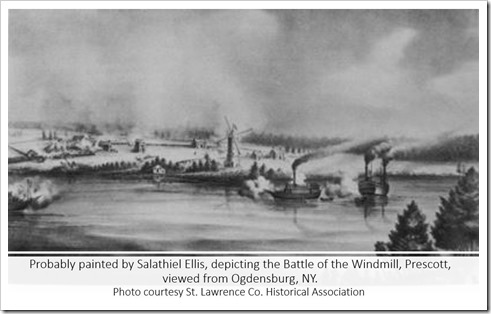
Beauclerk continued his narrative of events, adding the following details. He wrote; “Nov. 15th – Another attack was made. The Honourable Colonel [Henry] Dundas having arrived from Kingston, with four companies of the 83rd regiment, two eighteen-pounders, and a howitzer, and taken up position within a hundred yards of the enemy, with Captain Sandon [Sandom], with two gun-boats carrying two eighteen-pounders, commanded a position below the windmill. The gun-boats affected but little; but, after a cannonading against the buildings by Colonel Dundas, for an hour or rather more, the brigands attempted to escape, when the troops were ordered to advance. Very little resistance was offered from those occupying the windmill, but a smart fire was kept up from the adjoining stone buildings. White flag, however, having been displayed at the windmill, the occupants, were summoned to surrender unconditionally, which they did. Eighty-six prisoners were taken; and among them a Pole, calling himself General Van Sault [Nils Von Schoultz], besides sixteen others wounded, with a large supply of small arms, twenty-six kegs of powder, and three pieces of ordinance. All the buildings adjoining the mill were destroyed, but the mill itself spared, as a position of defence, in which some of the militia were quartered. Colonel Dundas was most active and through his humane efforts many brigands were protected from the violence of the enraged militia.”
In concluding remarks, Beauclerk noted that the Battle of the Windmill was “...nearly the last attempt made by the sympathisers [Patriots], in the exception of an attack on the Sandwich frontier [Battle of Windsor].” He ended his written comments by declaring that; “Tranquility was once more restored; but as a precautionary measure, important posts remained strongly garrisoned, and the whole frontier in a state of defence.” **
While the two recollections of the Battle of the Windmill provided above, are decidedly written from a loyalist view point and portray one specific perspective, they do provide additional information about this episode in the 1838 Upper Canadian Rebellion/Patriot War, which adds to the body of knowledge about this important historical event, some 180 years after its occurrence.
|
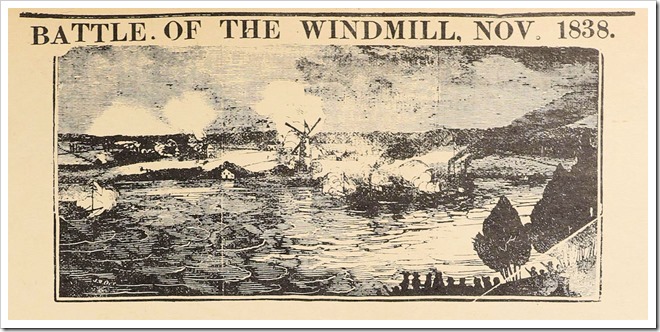 x x
Woodcut of the Battle of the Windmill by an unknown artist, commissioned by William Lyon Mackenzie, and published in Mackenzie's Weekly Message (July 30, 1859). Courtesy Chris Raible, Creemore
|
Endnotes:
*William Helliwell, who was a Captain in the First Regiment of the North York Militia, continued as a partner and manager of the family businesses at Todmorden Mills, until 1847. In that year disaster struck, as the brewery, distillery, and flourmill were all destroyed by fire. The family partnership was dissolved, and William moved to Highland Creek (now Scarborough), where he built and operated saw and grist mills. He died there on August 20, 1897.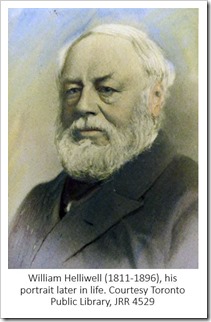
**During his time in the Canadas, Lord Charles Beauclerk was granted two leaves of absence by Sir John Colborne. On the first, he returned to England between September 1 and October 15, 1838, where he attended to urgent family matters. Beauclerk returned to his battalion after this initial leave, and served until the end of August 1839. A second leave was granted, which lasted from August 25, 1839, until August 24, 1840. He retired from his army career on April 15, 1842 and relocated to England to live in Northumberland. He appears to have rejoined the military in February of 1842, being listed in the London Gazette as a Major (an advancement in rank from Captain) and served in the Northumberland Infantry of Militia. The London Gazette also recorded Beauclerk’s death in its edition of August 22, 1862.
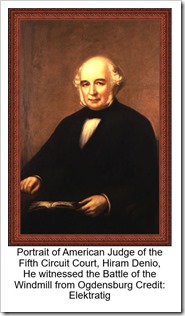 Bibliography and Recommended Reading: Bibliography and Recommended Reading:
Robert J. Andrews & Rosalyn Parker Art (eds.). A Troublesome Birth (Kingston: Kingston Historical Society, 2009).
Charles Beauclerk. “Operations at Prescot,” in Lithographic Views of Military Operations in Canada Under His Excellency Sir John Colborne (London: A. Flint, 1840).
John C. Carter. “Reflections on Rebellion: From the 1837 & 1838 Diaries of William Helliwell,” The York Pioneer (2018), v. 113.
John C. Carter. “Patriot Chronicles: Remembrances of the Battle of the Windmill,” Thousand Islands life Magazine (November 2013), v. 8, # 11.
James Croil. “The Battle of the Windmill,” Brockville Recorder (August 18, 1868).
The Diaries of William Helliwell (1838). Collection of the East York Foundation, East York, Ontario.
Hiram Denio. “Another letter Anent the Patriot Rebellion of the Battle of the Windmill,” St. Lawrence County Historical Association Quarterly (April. 1960), v. 5.
[Hiram Denio]. “Correspondence of the Argus, Steamboat United States,” Niles’ National Register (November 24, 1838).
[Hiram Denio]. “Seizure of the United States,” Brockville Recorder (December 6, 1838).
J.R. Judson. “The Patriot War Recollection of the Battle of the Windmill,” Ogdensburg Journal (November 21, 1892).
Roscius W. Judson. “Recollections of a Fight: The Battle of the Windmill as Viewed from Ogdensburg,” Ogdensburg Daily Journal (November 26, 1892).
Scott Morgan (ed.). “The Battle of the Windmill Revisited: As Recorded by Lieutenant Andrew Agnew, 93rd Highland Regiment of Foot, December 1838,” Canadian Military History (Autumn, 2000), v. 9, # 4.
n.a. “Battle of the Windmill,” Mackenzie’s Weekly Message (July 30, 1859).
Acknowledgements:
The author would like to thank Ulana Baluck, Bob Garcia, Ken Henry, Shaun McLaughlin, Chris Raible and John Schreiter for their advice and assistance in the writing of this article, as well as the East York Foundation for the use of the Helliwell Diaries.
|
By Dr. John C. Carter
Dr. John C. Carter is a frequent contributor to Thousand Islands Life Magazine. He is currently a Research Associate, History and Classics Programme, School of Humanities, University of Tasmania, and is Vice-chair of the East York Foundation. He can be contacted at drjohncarter@bell.net.
Click here to see all of the Dr. Carter’s Patriot Chronicles.